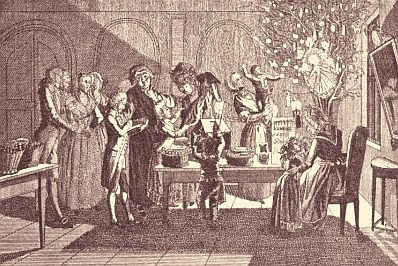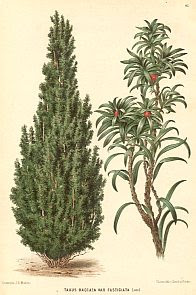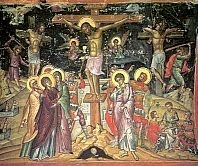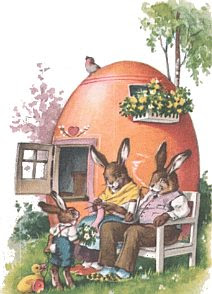
The noted blogger Fjordman is filing this report via Gates of Vienna.
For a complete Fjordman blogography, see The Fjordman Files. There is also a multi-index listing here.

Christmas is a festival celebrating the birth of Jesus, but many of our current practices, such as giving Christmas presents, are of a relatively recent date. Although a specifically Christian celebration, like many other European ideas it has been adopted in other parts of the world as a kind of secular holiday, somewhat to the dismay of devout Christians. Even non-Christian countries like Japan have adopted certain of its traditions, for instance Santa Claus, gift-giving, decorations and Christmas trees. The same is true of China, Thailand and other places where Christians are a minority. It also contains traces of pre-Christian practices in Europe.

Pagan Scandinavians in late December, around the time of the winter solstice, celebrated a festival called Yule. Present-day Scandinavians still call the Christmas season jul. The Christmas tree, an evergreen tree decorated with lights (originally candles) and ornaments, may also partly have older, pre-Christian roots. While its history is not entirely clear, the custom may possibly be traced back to the Baltic region, one of the last areas in Europe to be Christianized, to late medieval Estonia and Latvia and then to northern Germany from the sixteenth century on. The first use of candles on such trees is recorded in the early 1600s. The custom of creating Christmas trees remained confined to the upper Rhineland for generations, before it spread beyond the Protestant regions of Germany to the rest of Europe and the world.
In the Celtic religion, trees were seen as sacred objects, and the oak tree enjoyed a particular prominence. The name “druid,” referring to members of the learned class of priests among the Celts, originally meant “oak-knower.” The oak was the sacred tree of Zeus in ancient Greece. It was also often associated with the world tree in Slavic mythology while Yggdrasil, the huge world tree supporting the universe in Norse mythology, is usually identified as an ash tree. In the Völuspá, Ask was the first human man and Embla the first human woman, created by the gods from tree trunks. The meaning of Embla is uncertain, but Ask clearly means “ash tree.”
Professor Mary W. Helms reflects on the cultural significance of certain materials. The seagoing Dover Bronze Age Boat from England in the sixteenth century BC, for instance, was primarily constructed from oak and yew. Obviously, there are practical issues to consider such as the material properties of durability, elastic strength and resistance to rot (oak wood has great strength), but it is worth recalling that both the oak and the yew were widely recognized as cosmologically special species of trees, even sacred trees, in ancient European lore.
 The common yew — Taxus baccata — grows across much of the European continent. Ironically, it was simultaneously related to death (its leaves and seeds are toxic to humans and to livestock, though not to game) and to immortality since it is a very long-lived evergreen. Incredibly, the Llangernyw Yew, which grows in a churchyard in Llangernyw village in northern Wales, is thought to be more than four thousand years old, making it one of the world’s oldest living organisms. As for the oak, in the modern world it is often associated with the construction of fine furniture or the production of alcoholic beverages, for instance oak barrels for maturing wine, whiskey or cognac. In Celtic and Germanic cultures, that mighty tree was recognized as a cosmic axis mundi linking people with the sky and the gods:
The common yew — Taxus baccata — grows across much of the European continent. Ironically, it was simultaneously related to death (its leaves and seeds are toxic to humans and to livestock, though not to game) and to immortality since it is a very long-lived evergreen. Incredibly, the Llangernyw Yew, which grows in a churchyard in Llangernyw village in northern Wales, is thought to be more than four thousand years old, making it one of the world’s oldest living organisms. As for the oak, in the modern world it is often associated with the construction of fine furniture or the production of alcoholic beverages, for instance oak barrels for maturing wine, whiskey or cognac. In Celtic and Germanic cultures, that mighty tree was recognized as a cosmic axis mundi linking people with the sky and the gods:
Such an august association was probably very ancient. For example, Bronze Age northern Europe often utilised the oak as a coffin. Harding comments on the symbolic significance of such an interment, relating the oak tree-trunk coffin to house construction (also predominantly of oak in temperate Europe) and noting the relationship between houses and tombs both in Neolithic and Bronze Age contexts. He mentions, too, the ancient and long-lasting association of yews with graveyards (and churchyards) and the general connection of trees like ash, oak, and yew with longevity or eternal life; burial within a tree carrying the obvious connotation of a return to the source of life.
![]() Like Christmas, Easter consists of a mix of Christian and older, pagan symbols such as spring fertility rites. Many European languages use variations over the name of the Jewish festival Passover, called Pesach in Hebrew. In Italian, it’s Pasqua; in French, Pâques; in Spanish, Pascua; in Scandinavian languages Påsk or Påske; in Dutch, Pasen; and in Russian, Paskha, borrowed from the Greek via Old Church Slavonic. However, in German it’s called Ostern. The English Easter probably stems from Eostre, a Germanic goddess of spring and fertility.
Like Christmas, Easter consists of a mix of Christian and older, pagan symbols such as spring fertility rites. Many European languages use variations over the name of the Jewish festival Passover, called Pesach in Hebrew. In Italian, it’s Pasqua; in French, Pâques; in Spanish, Pascua; in Scandinavian languages Påsk or Påske; in Dutch, Pasen; and in Russian, Paskha, borrowed from the Greek via Old Church Slavonic. However, in German it’s called Ostern. The English Easter probably stems from Eostre, a Germanic goddess of spring and fertility.
Easter is the story of the death and resurrection of Jesus Christ. He was crucified in Jerusalem on Good Friday and was, according to believers, resurrected from the dead on the third day, having died for the sins and salvation of all mankind. This belief constitutes the very essence of the Christian religion. The date for Easter was settled during the First Council of Nicaea, presided over in person by the Roman Emperor Constantine I in AD 325. It also adopted the Nicene Creed, which is accepted as authoritative by all major branches of Christianity and affirms the divinity of Jesus and the Trinity of God the creator as Father, Son and Holy Spirit.
Easter is a moveable feast taking place after the Full Moon following the spring equinox, or at some point between March 22 and April 25 in the Gregorian calendar. Eastern Christianity of the Orthodox Churches continues to base its calculations on the older Julian calendar, which means that the dates of their Christian holidays currently differ from the Western ones.
In the Western Church, Easter was preceded by Lent, a forty-day period of fasting (excluding Sundays). In early Christian thought, gluttony (overeating) had been defined as one of the Seven Deadly Sins along with wrath, greed, sloth, pride, lust and envy. This was an era of scarcity. Lent is a partial fast where you abstain from certain types of food such as cheese, meat and eggs. This is very different from the fasting done by Muslims during Ramadan, who abstain completely from food and drink during the day for an entire month, including water in very hot countries, and then eat lots of cakes and watch TV during the night. Some types of fasting can have beneficial health effects, but this latter variety is not healthy for the body.
 The Roman Catholic Church imposed fasting during Lent. There were certain “lean days” when it was forbidden to eat “fat” food. Meat-eating was forbidden on almost 180 days — nearly half the year — but fish came to be regarded as suitable food for fast days. This meant that trade in fish could be quite profitable. Lofoten, the scenic Norwegian island group just north of the Arctic Circle, enjoys a climate that is technically classified as “temperate” due to the warm waters of the Gulf Stream that heat northwestern Europe. Since the Viking Age, if not before, stockfish — cod hung on wooden racks to be air-dried by the Sun and the salt breeze from the sea — has been made here. It has a long storage life. By medieval times it was exported via the port city of Bergen and the trading network of the Hanseatic League to Continental Western Europe. Salted cod (bacalao) is still popular in Portugal, Spain and Italy.
The Roman Catholic Church imposed fasting during Lent. There were certain “lean days” when it was forbidden to eat “fat” food. Meat-eating was forbidden on almost 180 days — nearly half the year — but fish came to be regarded as suitable food for fast days. This meant that trade in fish could be quite profitable. Lofoten, the scenic Norwegian island group just north of the Arctic Circle, enjoys a climate that is technically classified as “temperate” due to the warm waters of the Gulf Stream that heat northwestern Europe. Since the Viking Age, if not before, stockfish — cod hung on wooden racks to be air-dried by the Sun and the salt breeze from the sea — has been made here. It has a long storage life. By medieval times it was exported via the port city of Bergen and the trading network of the Hanseatic League to Continental Western Europe. Salted cod (bacalao) is still popular in Portugal, Spain and Italy.
 Lent ends with the Last Supper on Holy Thursday, when Christ is said to have given the ceremony of communion to his followers, the Twelve Disciples: “Take of this bread and eat of it, for it is my body. Take of this wine and drink of it, for it is my blood.” One of them, Judas Iscariot, betrayed Jesus and sold him out to Roman authorities for thirty pieces of silver:
Lent ends with the Last Supper on Holy Thursday, when Christ is said to have given the ceremony of communion to his followers, the Twelve Disciples: “Take of this bread and eat of it, for it is my body. Take of this wine and drink of it, for it is my blood.” One of them, Judas Iscariot, betrayed Jesus and sold him out to Roman authorities for thirty pieces of silver:
The next day, Good Friday, is the deepest day of mourning in the Christian religion because it is the day Christ was crucified (on a cross made of olive wood), died, and was buried. On Easter Sunday, Christians believe that Christ rose again and ascended into heaven. Eggs were forbidden during Lent, but were used heavily in ritual foods when fast was broken on Easter Sunday. They were in special egg breads like Ukrainian paska or Russian saffron-scented kulich. Sometimes the bread is decorated with dyed hard-boiled eggs or shaped into a cross. For Easter dinner, traditional foods depend on geography. In the Mediterranean, it is lamb; in Northern Europe, ham; in England, beef. The custom of giving painted eggs for Easter dates to the later Middle Ages. Baskets to hold the eggs represent birds’ nest. The Easter Bunny with his basket of painted eggs came to America with German immigrants in the nineteenth century.
 The Easter lamb here refers to Jesus himself, as Christ was seen as “the Lamb of God.” To Christians they constitute a symbol of the Resurrection, but eggs are a self-evident symbol of creation and rebirth. The use of painted and decorated Easter eggs was first recorded in the Late Middle Ages.
The Easter lamb here refers to Jesus himself, as Christ was seen as “the Lamb of God.” To Christians they constitute a symbol of the Resurrection, but eggs are a self-evident symbol of creation and rebirth. The use of painted and decorated Easter eggs was first recorded in the Late Middle Ages.
The only possible ancient parallel is found among the Jews, the soup with hardboiled eggs of Passover, served after the Seder ceremony. There are no references earlier than the fifteenth century which mention the distribution of eggs at Easter, but from the sixteenth century on there are plenty. A tradition that eggs are brought by a hare or bunny is found in German lands, but it goes no farther back than the seventeenth century. It was the subject of a medical dissertation at Heidelberg in 1682, where it was announced as a novelty:
In some parts of Germany, instead of a hare, a bird or a fox brings eggs, or eggs may fall from the sky, together with church bells returning from a trip to Rome to be blessed. This started as a popular rather than a genuine folk custom of the South of France in the mid-nineteenth century, and was encouraged if not actually suggested by the clergy in an effort to make Easter celebrations more religious. Confectioners have spread the idea to all other countries, eggs and bells being an excellent way to market chocolate. Decorated eggs are not by any means all meant to be kept; most are eaten. However, in Romania and the Ukraine the shells are saved to be thrown in the river (an ancient gesture with various different kinds of significance). The shells go down into the other world to tell the dead to be of good cheer: Christ is risen, and all at home are rejoicing.

Just an amplification on Russian Lent. In Lev Tolstoi’s The Death of Ivan Iljich he explains that Lent served to prevent farmers, at the end of a long harsh winter, eating their breeding stock and seeds. Hunters wouldn’t hunt pregnant game as the meat was forbidden food.
Easter Eggs Called “Spring Spheres”?
By WKBW News April 23, 2011
Updated Apr 23, 2011 at 8:45 AM EDT
Buffalo, NY (ABC-WKBW)
A Seattle school renamed Easter eggs “Spring Spheres” in an effort to make the eggs non-religious symbols. A teen who volunteered at the school told MyNorthwest.com, “When I took them out of the bag, the teacher said, ‘Oh look, spring spheres‘ and all the kids were like ‘Wow, Easter eggs.’ So they knew.” Seattle Public Schools spokesperson Teresa Wippel said in a Seattle PI blog that the school board stated that they have a Religion and Religious Accommodation’ policy which makes a point not to promote any “religious belief or non-belief.”
http://www.wkbw.com/news/local/Eggs-Too-Religious-Called-Spring-Spheres-at-a- School-120536694.html
Sheer stupidity to rename such innocent symbols. Think back to the French Revolution, when all religious references and practices were prohibited. That was certainly a constructive period.